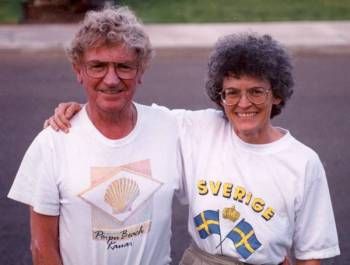|
Day 1 |
Probing America: High Tech on Back Roads Day 16 Twin Falls, Idaho, to Pendleton, Oregon July 9, 1992 You know a trip is getting long when you are impressed with the cleanliness and style of a McDonalds. That happened to us today in Meridian, Idaho, which appears to be the booming suburb outside of Boise. You can tell it is booming because the Pizza Hut, which is next to the McDonalds, is at the corner of Progress Circle and Corporate Drive--we kid you not. The highpoint of the day, and perhaps for many days, came in Baker City, Oregon. For those of you who use to live in Oregon, you probably remember the town as Baker; but the city mothers and fathers decided about a decade ago to rename to the original Baker City, and it appears to have done something for their civic pride because the little town of 10,000 is doing a lot of things. Baker is the home to the new Oregon Trail Interpretive Center. All told, there are to be four by the 150 anniversary of the Oregon Trail which is in 1993. This center opened on May 23 of this year with lots of hype that those of us in the Willamette Valley took with a grain of salt. Well, we are here to tell you this is spectacular and well worth the drive even if that is from Auckland. The buildings of the center are located on top of Flagstaff Hill, about 5 miles off I-5 from Baker City. The wagon train ruts which first appeared in 1843 can be seen from the center, and walked by following the asphalt trails. It is only a matter of time before tourists, wanting "real souvenirs", will eradicate the sections of trail, piece of dirt by piece of dirt. A description would not do it justice. The multi media display is often startling in both its realism and providing a sense of what the emigrants experienced on the 220 day crossing. As many as ten percent of the people who departed Missouri on a wagon train would die on the trail. The Interpretation Center illuminates how the emigrants became one of their own main obstacles. Each passing wagon train made the journey more trying for the next. To quote from a booklet: "The heyday of the trail occurred after gold was discovered in California in 1848. During the next few decades it is estimated that 300,000 people came west over the Oregon Train. Travel became so heavy pioneers complained it was like one continuous wagon train snaking its way west. Their stock over-grazed a forty-mile swath, great numbers of buffalo, antelope and rabbits were killed for food and, because of unsanitary camping conditions, the pioneers suffered from epidemics of cholera and mountain fever." Substitute campers, station wagons, and moving vans for covered wagons and it sounds like a prediction for things to come on I-5 as disillusioned Californians turn, as did the pioneers, to the Pacific Northwest for opportunity and the good life. We agreed visiting the center at the end of our journey, rather that at the beginning, was fortunate. You have gathered that traveling east we were reminded of the vastness of the land. Leaving the midwest, we essentially followed the routes of those pioneers of the mid 1840s. It took us 6 days (in a push could be done overland by car in 4) to complete their 210 day trek. We were, one might say, set up for Flagstaff Hill. The western land is so vast and uninhabited. Water, or lack of it, must be the primary reason. But when there is an opportunity for gain, the pickups and double-wides gather. In Montana and Wyoming, after driving through miles of nothing, one looks out from a sudden rising of the highway to see people extracting oil or gas, digging ore, organizing cattle, or guarding prisoners. Tiny communities, but they found water. Drive by 5 years later and there will be young trees starting to shade the double wides and patches of grass in front of two or three. Come fall or winter, reading about water will be a high priority...along with Indians, emigrants, and the financing of improved highways. We would like to know more about these things.
On other fronts we are doing our own "what should we do after the Oregon Trail" discussion. The Interpretive Center made it quite clear that the emigrants still had to decide what to do with themselves after they reached Oregon City. Well, we reach Oregon City tomorrow and we are faced with the same question. Trips and experiences like these always motivate us to rethink what we are doing and why. This was no exception. We had a good discussion after McDonalds (near the corner of Progress and Corporate) this morning until Baker City. We have a list to review tomorrow and will probably add a bit more to it before we reach the headquarters of The Think Pink at Charbonneau, which, ironically, is one of the first areas inhabited by the Oregon Trail settlers. We shall try to use the past 16 days experience to spur us on to some new things, or at least old things in new packages. Thanks again for traveling along with us. We hope it didn't get too crowded in the back seat of the Probe, because your coming along enhanced the pleasure of the journey. Good night and goodby.....and take care
|


